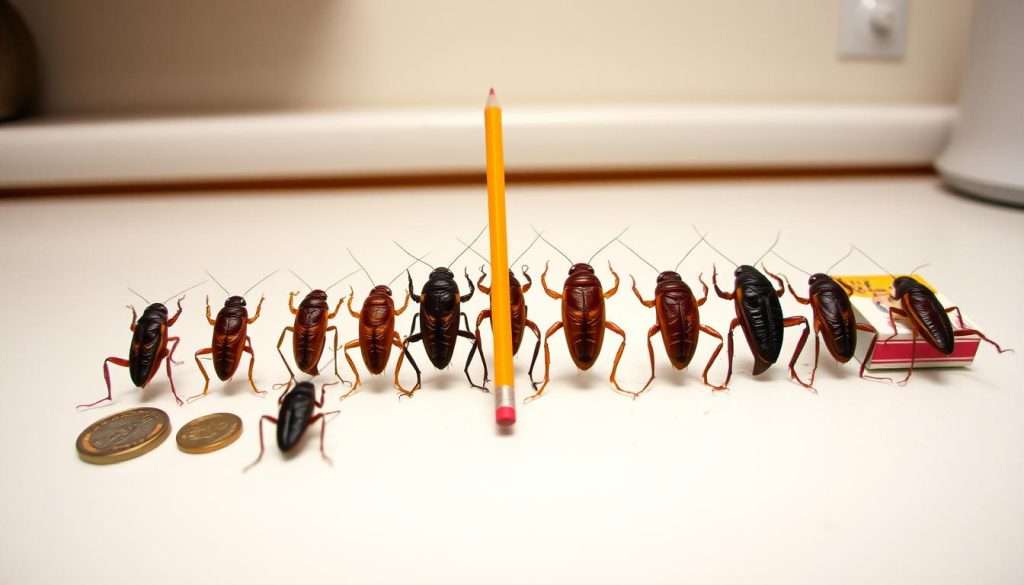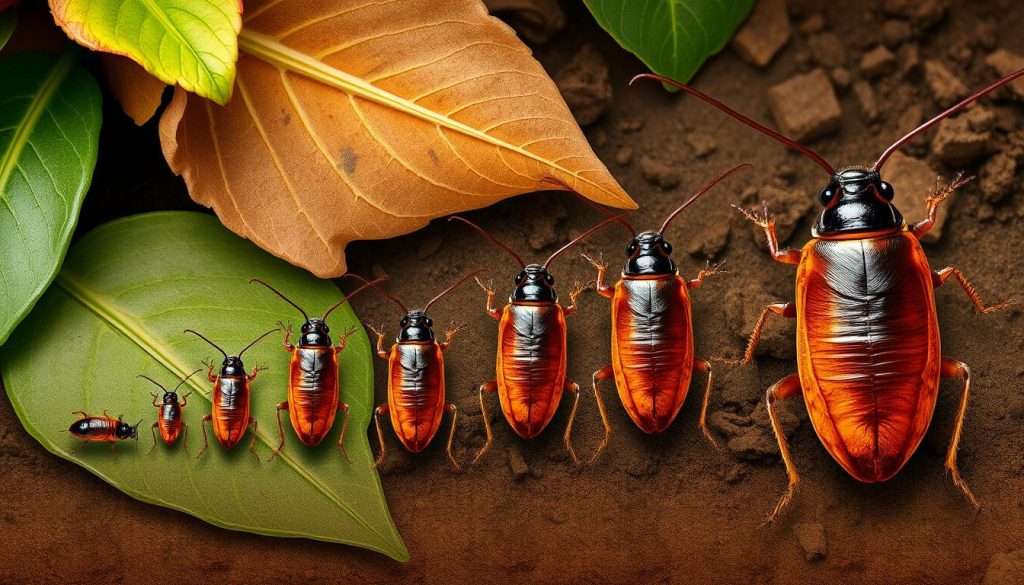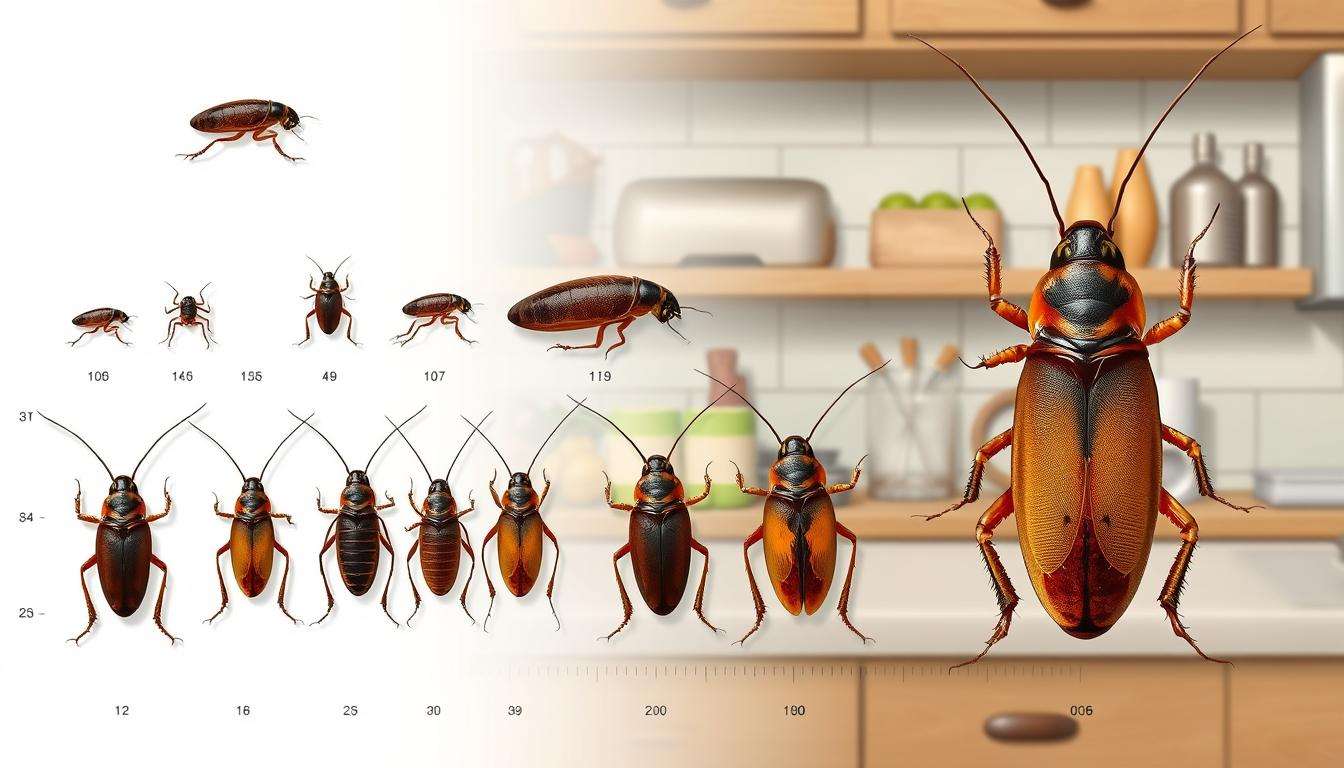Cockroaches are found all over the world. There are over 4,000 different kinds, and about 40 of them live in the United States. Knowing how big they are helps figure out what kind you have.
From the brownbanded and oriental to the American cockroaches, their sizes vary a lot. This knowledge is key to spotting and managing these pests.
The biggest cockroach can grow up to six inches long. It can even have a wingspan of nearly one foot. Keeping your home free from cockroaches is important. In this article, we’ll look at how big cockroaches can get and share useful facts.
Key Takeaways
- Cockroaches spend about 75% of their time resting.
- The largest cockroaches can grow to six inches long and have a wingspan of a foot.
- Understanding cockroach sizes can help spot infestations.
- More than 4,000 species of cockroaches exist worldwide.
- Cockroaches can adapt to many environments, making them hard to get rid of.
Understanding Cockroach Size Variability
Cockroach sizes vary due to many factors. Homeowners need to know this well. There are about 4,000 cockroach species worldwide. Around thirty live in human homes, especially in places like Michigan, Ohio, and Indiana.
Factors Affecting Cockroach Size
Several factors affecting cockroach size play a role in their size and growth:
- Species Variability: Different species have different sizes. For example, the German Cockroach is 1/2 to 5/8 of an inch. The American Cockroach can be 1 3/8 to 2 inches long.
- Habitat: Where they live affects their size. Cockroaches in warmer places grow bigger than those in colder areas.
- Diet: What they eat also matters. Food helps them grow.
- Environmental Conditions: Humidity and temperature also matter. They grow faster in warm, moist places.
Diversity Among Cockroach Species
There’s a lot of diversity among cockroach species. This leads to many different sizes. For example:
- The Oriental Cockroach is 0.8 to 1.2 inches long. It likes sewers or old buildings.
- The Smokeybrown Cockroach is 1 to 1.5 inches. It often comes into homes from southern states.
- Smaller cockroaches, like the Brown-banded, are about 1/2 inch. They are less common but can still infest homes.
To learn more about different cockroaches, check out common types of cockroaches in cities.
How Big Can a Cockroach Get – Overview of Species Sizes
Cockroaches are really interesting, especially when you look at how big they can get. Different species can be quite different in size. Knowing about common household cockroach sizes and the differences between urban and rural areas can help fight pests.
Common Household Cockroach Sizes
Household cockroaches come in many sizes. Each type has its own special features. Here are some of the most common ones:
| Cockroach Species | Adult Size | Development Time (Egg to Adult) |
|---|---|---|
| German Cockroach | About 17 mm (5/8 to 2/3 inches) | 55-68 days |
| Brown-banded Cockroach | Similar to German or slightly smaller | 95-276 days |
| American Cockroach | About 4 cm (1 1/2 inches) | Not specified |
| Oriental Cockroach | About 2.5 cm (1 inch) | 300-800 days |
| Pennsylvania Wood Cockroach | Male: 7/8-1 1/8 inches; Female: 1/2-3/4 inches | Not specified |
Comparison of Urban vs. Rural Cockroach Sizes
The place where cockroaches live can affect how big they get. In cities, there’s more food, so cockroaches can grow bigger. Here’s how they differ:
- Urban cockroaches have more food, which helps them grow bigger.
- Rural cockroaches face more natural enemies, which keeps them smaller.
- City cockroaches find shelter in buildings, which changes their size and how they adapt.
- Rural areas have different habitats, which affect cockroach size based on resources and environment.

The Largest Cockroaches in the World
Some cockroaches are huge, making them both fascinating and scary. They come from all over the world. Each species is known for its big size.
Giant Burrowing Cockroach
The giant burrowing cockroach is one of the biggest cockroaches. It’s from Australia and can be 8 inches long. They live for about 10 years, which is very long for cockroaches.
Other Notable Giant Cockroach Species
The Megaloblatta genus is famous for its giant cockroaches. The Megaloblatta longipennis is the biggest, with a body length of 4 to 9.7 cm and a wingspan of up to 20 cm. They can be found in many places:
| Species | Length | Wingspan | Location |
|---|---|---|---|
| Megaloblatta longipennis | 4 to 9.7 cm | Up to 20 cm | Colombia, Ecuador, Peru |
| Megaloblatta blaberoides | 4 to 9.7 cm | Up to 20 cm | Southern Mexico, Central America, Colombia, Ecuador |
| Megaloblatta insignis | 4 to 9.7 cm | Up to 20 cm | French Guiana, Suriname |
| Megaloblatta regina | 4 to 9.7 cm | Up to 20 cm | Amazonian Ecuador, Brazil |
The Caribbean Giant Cockroach is also very big. Females can be up to 4 inches long, and males up to 3 inches. They are active at night and live in dark, damp places. They help break down organic matter. These facts show how diverse and interesting giant cockroaches are.
Cockroach Growth Stages and Maximum Size
Cockroaches go through many growth stages. This journey affects their biggest size. Knowing about the life cycle of cockroaches helps homeowners deal with them better. Each stage has its own traits that show how they grow.
Life Cycle of a Cockroach
The life cycle of cockroaches has three main parts: egg, nymph, and adult. Female cockroaches can lay 5 to 30 egg capsules. Each capsule has 10 to 60 eggs.
Nymphs take 40 to 160 days to grow up. For example, the American cockroach starts as an egg. It goes through 13 molts as a nymph. Then, it grows to about 1.5 inches long as an adult.
Growth Rate of Various Species
Not all cockroaches grow at the same rate or reach the same size. The German cockroach grows to about 0.5 inches long. The American cockroach can grow up to 1.5 inches long.
Brown-banded cockroaches are similar in size to German cockroaches. They can reproduce fast, which can quickly increase their numbers. Knowing these differences is key to managing cockroach growth in your home. For more information on the life cycle of cockroaches, check out detailed resources.

Cockroach Anatomy and Size Measurement
Knowing about cockroach anatomy helps us measure their size right. It’s key for fighting pests and figuring out which cockroach is causing trouble. We’ll look at how to measure their body length and other parts, and give tips for getting it right.
Understanding Body Length and Dimensions
Cockroach sizes vary a lot, with over 4,600 types. The Australian giant burrowing cockroach can grow up to 8 centimeters long. On the other hand, some, like Attaphila, are just 3.5 mm. Knowing these sizes helps us tackle infestations better.
Measuring Cockroach Size Accurately
Measuring cockroach size needs careful steps. Here’s how to do it right:
- Use a ruler or caliper for precision.
- Measure from the head to the tip of the abdomen to get the body length.
- For big ones, use millimeters for better accuracy.
- Write down the measurements right away for later use.
Here’s a table comparing the lengths of different cockroach species:
| Cockroach Species | Average Body Length (mm) | Weight (grams) |
|---|---|---|
| American Cockroach | 44 | 30 |
| Austrailian Giant Burrowing | 80 | 35 |
| Megaloblatta longipennis | 97 | Unknown |
| Attaphila | 3.5 | Unknown |
Conclusion
Looking into how big cockroaches can get shows us their size variety is fascinating. It also highlights the need to know how to handle these pests well. With over 4,500 species worldwide, knowing their sizes is key for effective pest control.
The German cockroach is tiny, while the American cockroach can grow up to three inches. This knowledge helps us plan better against these pests.
Cockroaches have lived with humans for ages, with about thirty species in our homes. Knowing their size helps spot infestations early. They can even survive without a head for a week or go without food for a month.
This shows we need to act fast to keep our homes safe. Understanding cockroach size and behavior helps us manage pests better. It makes our homes healthier places to live.
